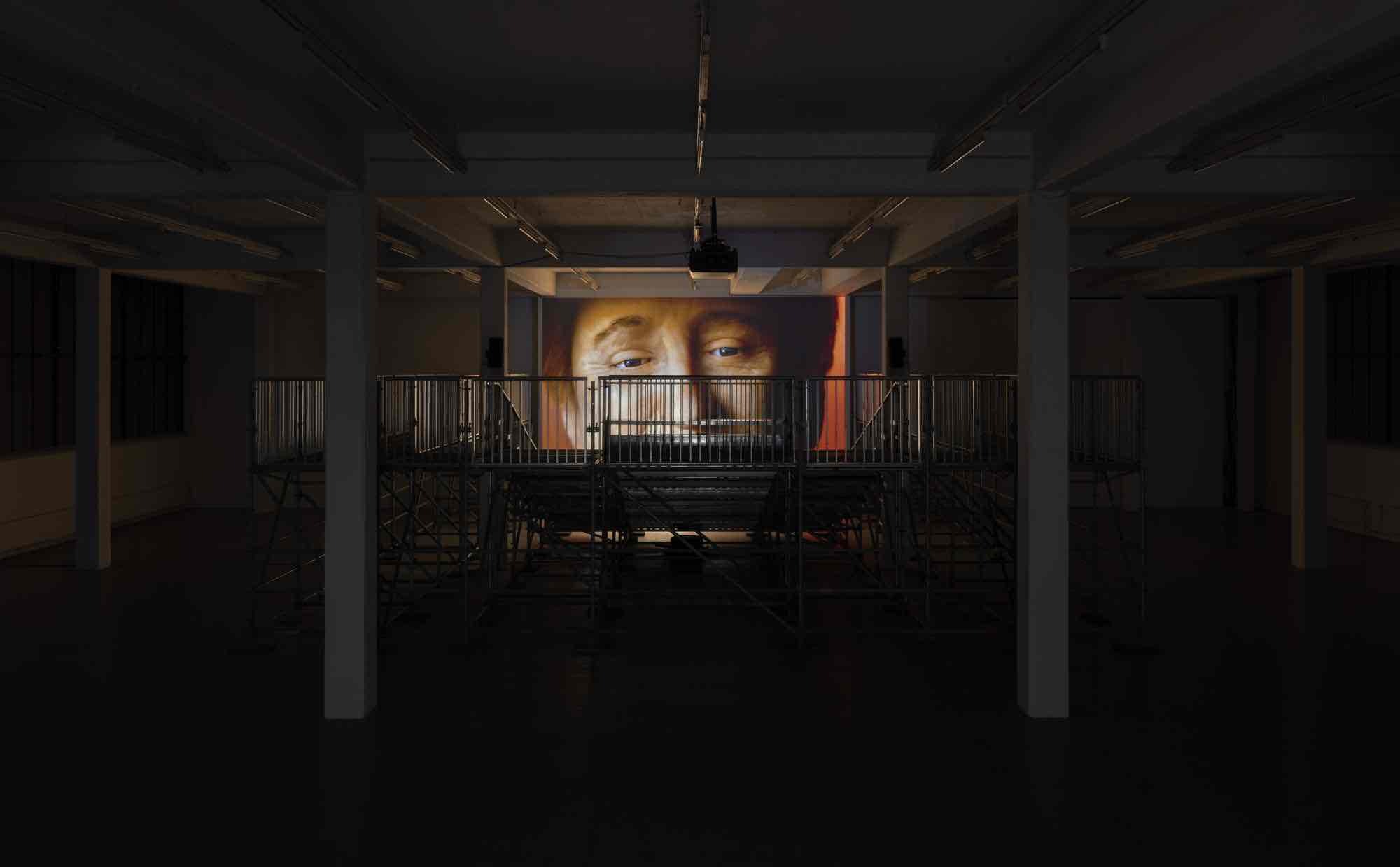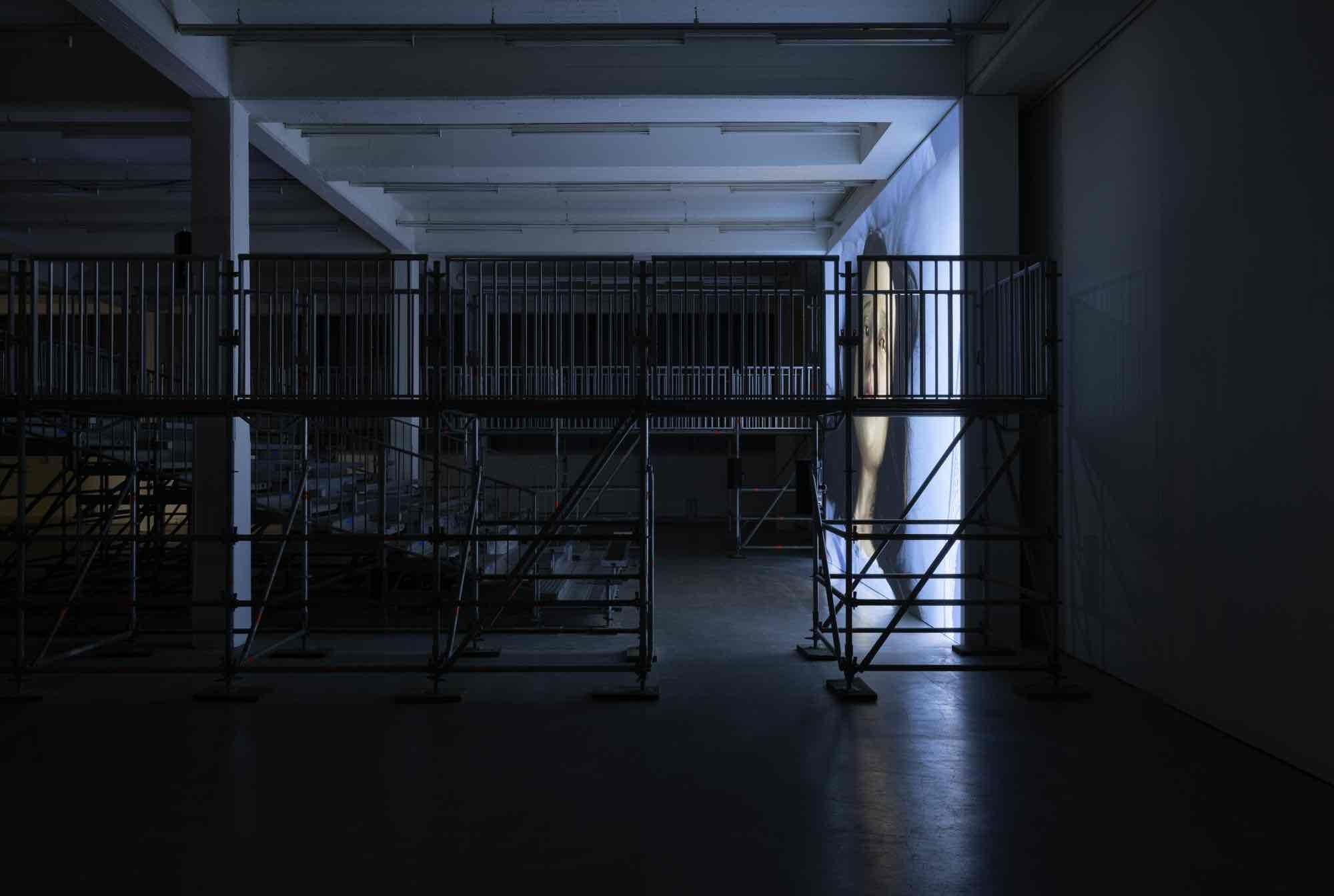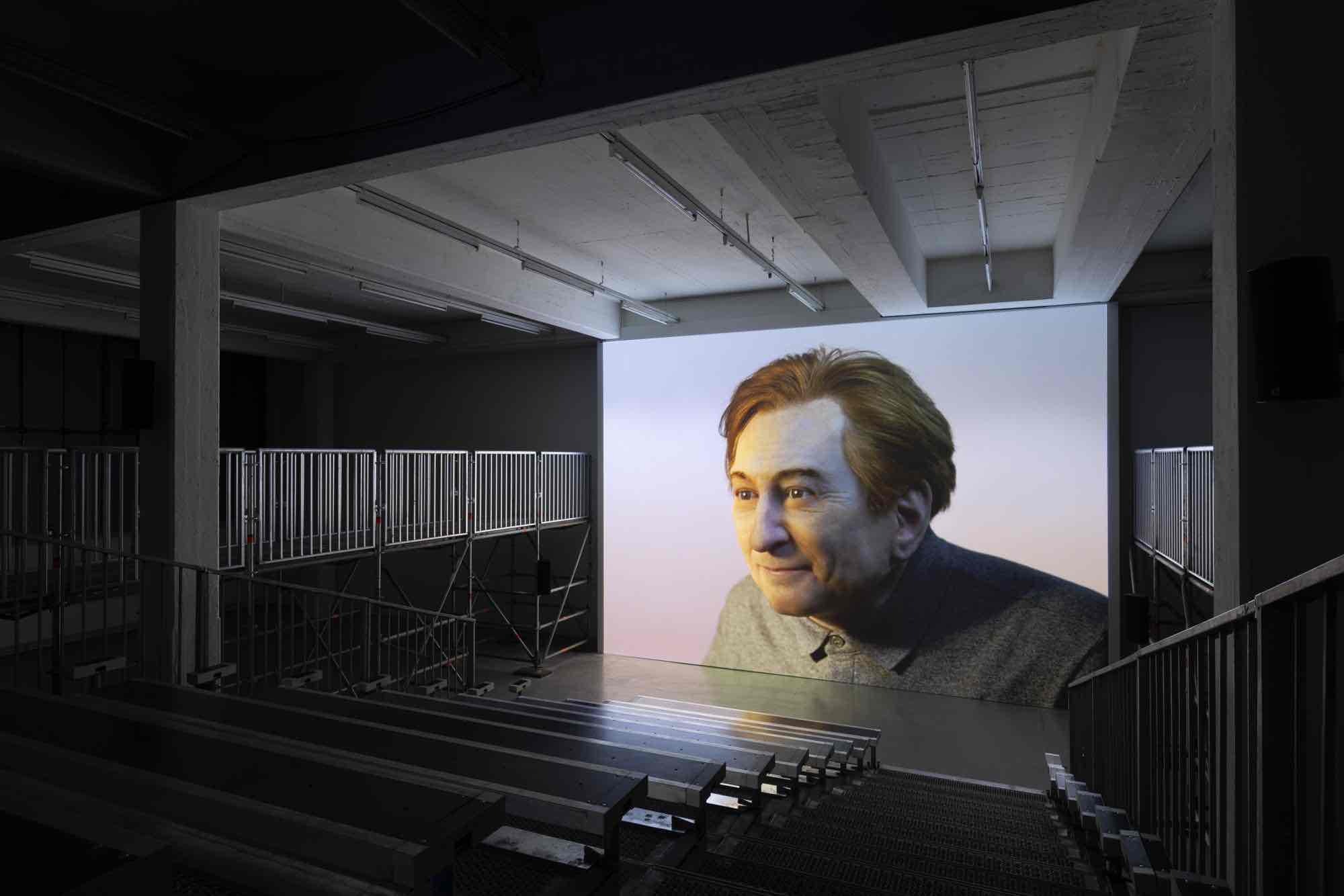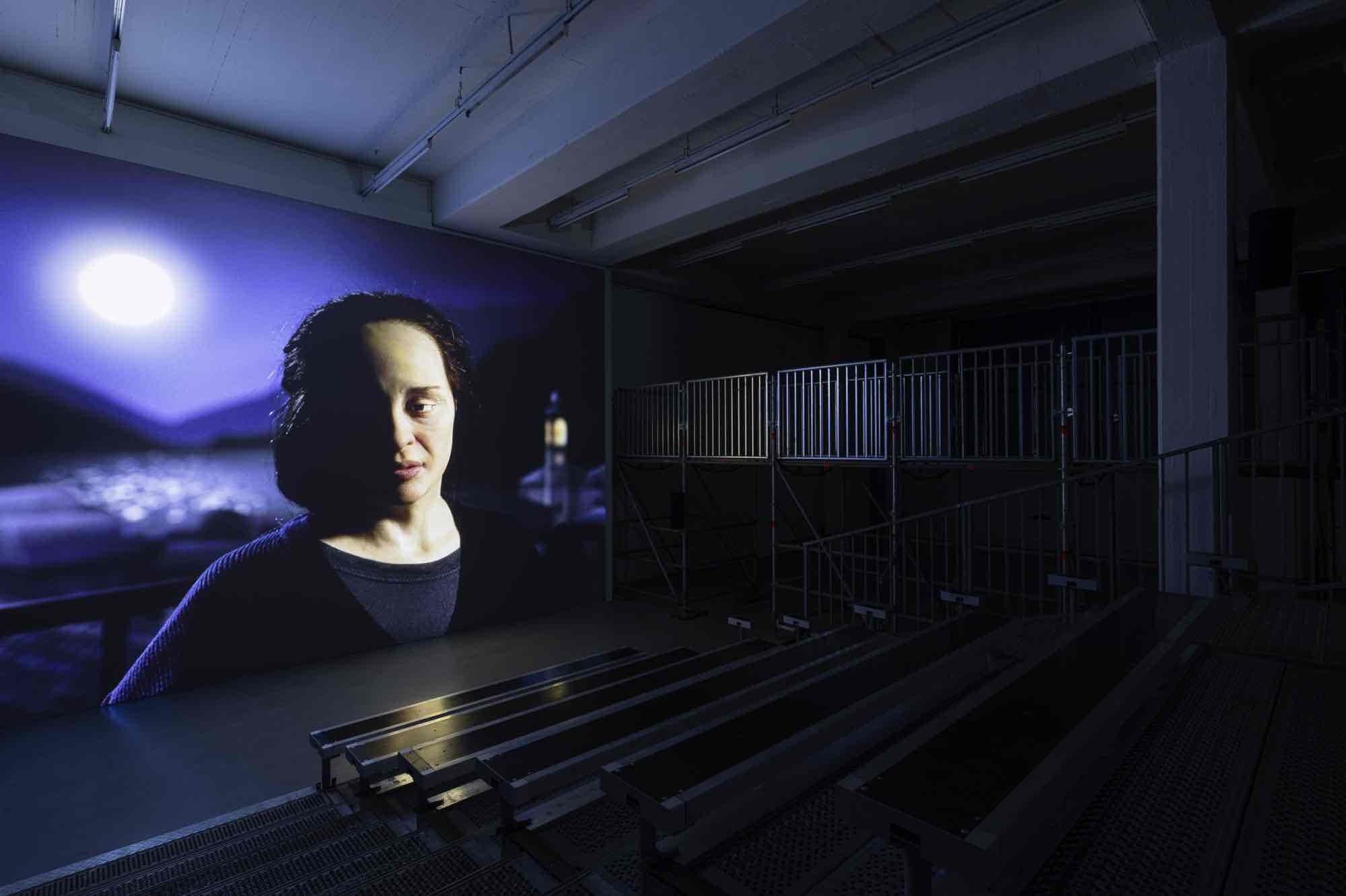Diego Marcon
La Gola
04 May - 11 Aug 2024
La Gola (The Belly), Diego Marcon’s film commissioned by the Kunstverein in Hamburg revolves around the correspondence between Gianni and Rossana. The two characters are portrayed by hyperrealistic dolls with digitally animated eyes and facial expressions. The storyline connects three levels, each of which progresses towards a climax—a splendid dessert, the declining health and sensory disorder of Rossana’s mother, and a rising musical crescendo. Everything—the figures, the relationships, the narrative structure, the genre-specific conventions—is in a state of irresolve, while inner and outer worlds merge in a camp and overinflated magical realism.
Although the cast of La Gola is confined to two protagonists, the film reveals a tangled web of relationships characterised by plight and jouissance. In frontal closeups set in daylight to the sound of chirping birds, Gianni lauds the skills of his cook Baptiste; his life’s aim is seeking heightened forms of pleasure. Rossana, on the other hand, writing in nocturnal darkness shaken by increasing thunder and lightning, describes her mother’s physical suffering and progressing illness. Rossana’s life is defined by the absence of pleasure, her entire existence devoted to caring for her mother. However asymmetrical the relationship between Gianni and Rossana may be, they share the inability to recognise the written language of the other as real physical experience. The scenic juxtaposition and the interplay of day and night reinforce the all-dominant contrast between autonomy and dependence. A distinctive feature of the melodramatic narrative structure is its inescapable teleological course, emphasised by the score composed by Federico Chiari, which was recorded on a Pietro Corna organ in Bergamo Cathedral.
The combination of human voices, analogue dolls, and digital (post-)production brings forth hybrid characters whose status between analogue and digital defies clear distinction. Triggering the notion of the “Uncanny Valley”, the moment in the history of technology and culture in which the humanity of technology causes a sense of unease: The figures are too human to be perceived as clearly lifeless, but not human enough to be mistaken for actual humans. Marcon’s work creates a filmic reality that questions issues related to the representation and depiction of human beings in cinema.
La Gola is distinguished by a camp exaggeration of its cinematic medium—its codes, its language, and its structure. The beauty of the images goes hand in hand with a feeling of discomfort. By deploying conventions of a certain genre, the film engenders expectations at once alluring and unsettling. The narrative structure, language, and images are characterised by formal cinematic quotations and references to historical horror films such as Giallo, a genre developed by Dario Argento, and the melodramas of Douglas Sirk, but also musicals and children’s television. The film thus evokes an emotional ecology that echoes the melancholy of cinema’s past and the alienation of cinematic genres.
The true nature of Gianni and Rossana’s relationship remains a mystery. Their correspondence is devoid of true empathy. On the contrary, La Gola avails itself in auteur conventions, where dialogue comes to bear as only one of several formal filmmaking devices and instruments. Gianni and Rossana are foils, gendered stereotypes of cinema history charged with affect. They are doomed to make their way from one stage set to the next in an overdetermined and stylistic, but ultimately plot- and actionless vacuum.
Curated by Milan Ther
Although the cast of La Gola is confined to two protagonists, the film reveals a tangled web of relationships characterised by plight and jouissance. In frontal closeups set in daylight to the sound of chirping birds, Gianni lauds the skills of his cook Baptiste; his life’s aim is seeking heightened forms of pleasure. Rossana, on the other hand, writing in nocturnal darkness shaken by increasing thunder and lightning, describes her mother’s physical suffering and progressing illness. Rossana’s life is defined by the absence of pleasure, her entire existence devoted to caring for her mother. However asymmetrical the relationship between Gianni and Rossana may be, they share the inability to recognise the written language of the other as real physical experience. The scenic juxtaposition and the interplay of day and night reinforce the all-dominant contrast between autonomy and dependence. A distinctive feature of the melodramatic narrative structure is its inescapable teleological course, emphasised by the score composed by Federico Chiari, which was recorded on a Pietro Corna organ in Bergamo Cathedral.
The combination of human voices, analogue dolls, and digital (post-)production brings forth hybrid characters whose status between analogue and digital defies clear distinction. Triggering the notion of the “Uncanny Valley”, the moment in the history of technology and culture in which the humanity of technology causes a sense of unease: The figures are too human to be perceived as clearly lifeless, but not human enough to be mistaken for actual humans. Marcon’s work creates a filmic reality that questions issues related to the representation and depiction of human beings in cinema.
La Gola is distinguished by a camp exaggeration of its cinematic medium—its codes, its language, and its structure. The beauty of the images goes hand in hand with a feeling of discomfort. By deploying conventions of a certain genre, the film engenders expectations at once alluring and unsettling. The narrative structure, language, and images are characterised by formal cinematic quotations and references to historical horror films such as Giallo, a genre developed by Dario Argento, and the melodramas of Douglas Sirk, but also musicals and children’s television. The film thus evokes an emotional ecology that echoes the melancholy of cinema’s past and the alienation of cinematic genres.
The true nature of Gianni and Rossana’s relationship remains a mystery. Their correspondence is devoid of true empathy. On the contrary, La Gola avails itself in auteur conventions, where dialogue comes to bear as only one of several formal filmmaking devices and instruments. Gianni and Rossana are foils, gendered stereotypes of cinema history charged with affect. They are doomed to make their way from one stage set to the next in an overdetermined and stylistic, but ultimately plot- and actionless vacuum.
Curated by Milan Ther






